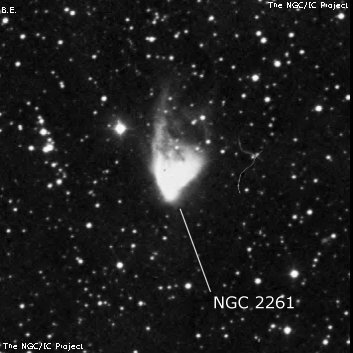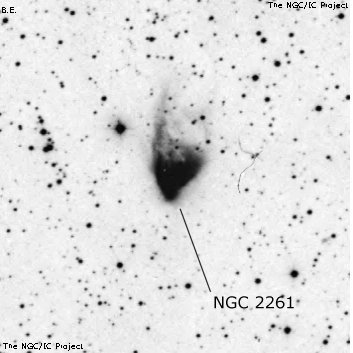NGC/IC Project Restoration Effort
(This is a very very beta version)
NGC2261


Basic Information
Location and Magnitude
Right Ascension: 6:39:9.5
Declination: +8:44:40
Constellation: MON
Visual Magnitude:
Historic Information
Discoverer: Herschel W.
Year of discovery: 1783
Discovery aperture: 18.7
Observational
Summary description: B, vmE 330°, N com = * 11
Sub-type: EN+RN
Corwin's Notes
=====
NGC 2261 is often called "Hubble's Variable Nebula" as its variability was
indeed first noticed by Hubble during his years at Yerkes Observatory. The
nebula was discovered, though, by WH in 1783, and is the second of his new
class of "planetary" nebulae. We know now that the nebulosity is actually
enveloping a very young double star system, R Monocerotis. The star's
variability was first noted by Schmidt (AN 55, 91, 1861). The variability of
the nebula is probably the result of circumstellar clouds close to the stars
casting shadows on the surrounding nebulosity. NGC 1554/5 (which see) around
T Tauri is another example.
Steve's Notes
=====
NGC 2261
18" (3/4/08): Hubble's variable nebula is a striking fan-shaped object, with a mag 12 star at its south tip with the nebula extending to the north. The fan displays a great deal of variation in brightness and structure at 300x. The brightest portion is on the northwest side of the fan, though it dims a little near the tip on the west side. The eastern rim is bright and sharply defined N-S like a thin finger. The nebulosity dims along northern end of the fan and a small, wedge-shaped darker area extends into the fan from the north.
13.1" (1/28/84): Hubble's Variable Nebula is bright, small, fan-shaped 2:1 N-S and widest at the north boundary. The nebulosity tapers down towards 12th magnitude R Monocerotis at the south tip which appears to have a very small high surface brightness halo. The western edge (oriented NW-SE) is slightly weaker and more curved than the eastern edge which is sharper and straighter N-S. This is an impressive nebula with high surface brightness and interesting structure.
8": comet-like nebula extends from R Mon.



